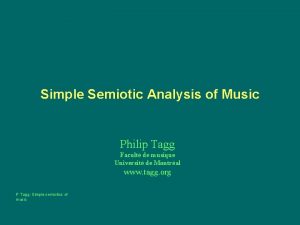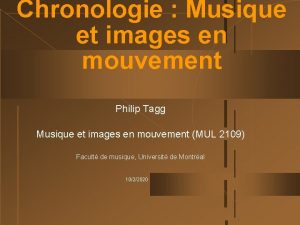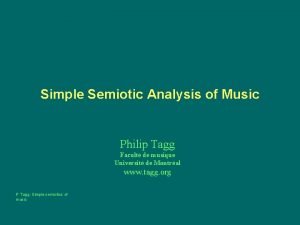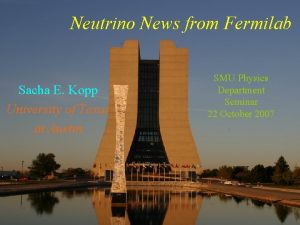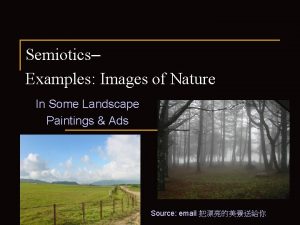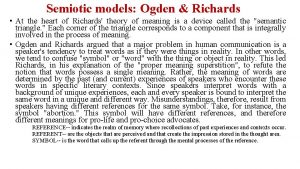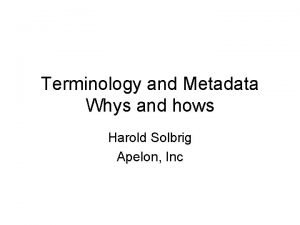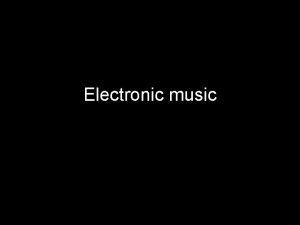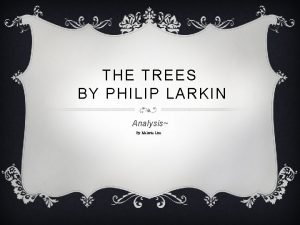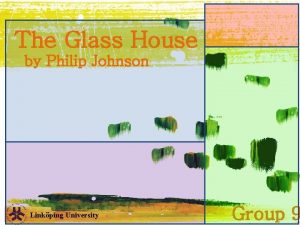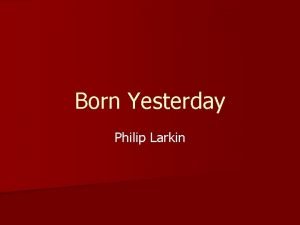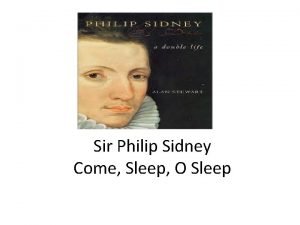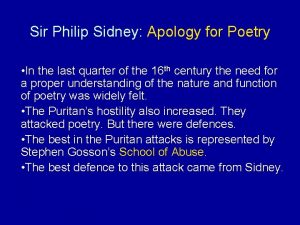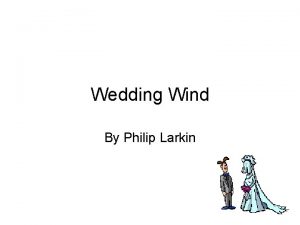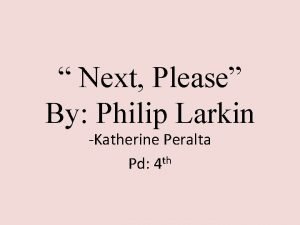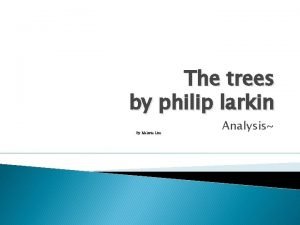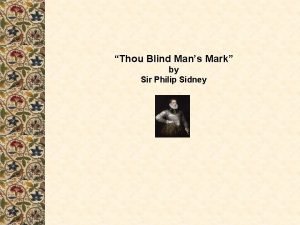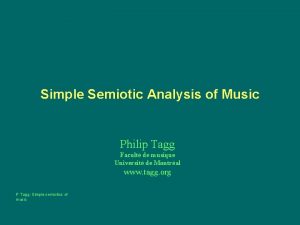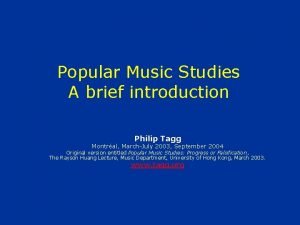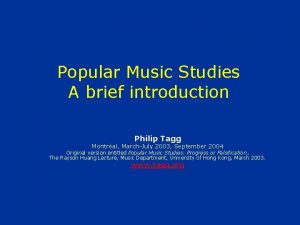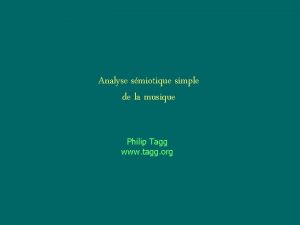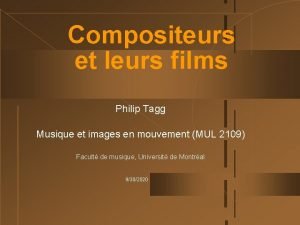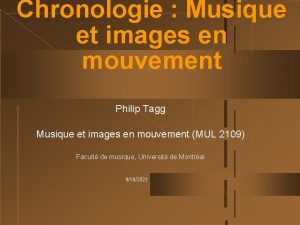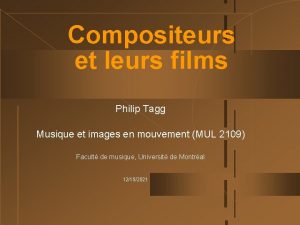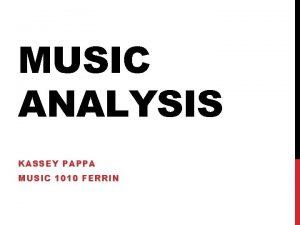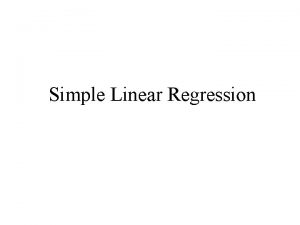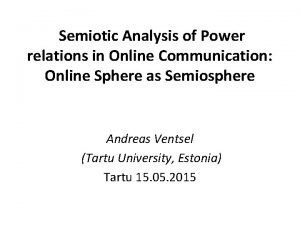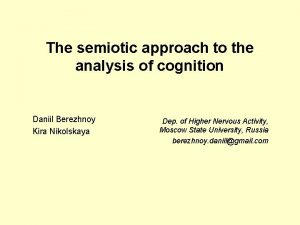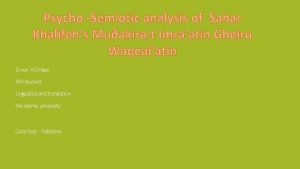Simple Semiotic Analysis of Music Philip Tagg Facult





















![Parameters of musical expression (2) • temporal parameters • duration: [1] of piece and Parameters of musical expression (2) • temporal parameters • duration: [1] of piece and](https://slidetodoc.com/presentation_image/35fba421f1b04aabec231a310bdb8d74/image-22.jpg)






- Slides: 28

Simple Semiotic Analysis of Music Philip Tagg Faculté de musique Université de Montréal www. tagg. org P Tagg: Simple semiotics of music

Communication Model P Tagg: Simple semiotics of music shared by Emitter and Receiver emitter only poïetic / constructional Intended ‘message’ o f s y m b o l s receiver only codal incompetence ‘inadequate’ encoding Emitter ‘inadequate’ response Music Receiver (channel) ‘inadequate’ encoding emitter only ‘inadequate’ response codal interference receiver only s o c i o c u l t u r a l n o r m s shared by Emitter and Receiver esthesic / receptional s t o r e ‘adequate’ response

1 Elementary semiotic considerations

Semiotics or semiology ? • / (sema/semeion) = sign (semiotics, semiology, semantifs, semaphore, etc. ) The study of signs and of what they represent Charles Sanders Peirce : semiotics, tripartite model Ferdinand de Saussure : semiologie, binary model same basic subject, different terms and models

Sign or symbol ? (terminological problem) symbol (Saussure) = sign (Peirce)! meaning: any ‘thing’ representing any other thing than itself SIGN symbol (Peirce) = sign (Saussure)! a ‘thing’ representing another thing only by convention ARBITRARY SIGN

= process of producing and interpreting signs C. S. Peirce: Semiosis 1, 2, 3 (1) • Firstness (emission) • The thing/idea perceived before encoding (poïetic pole) Secondness (the ‘channel’) The object (firstness) encoded • Thirdness (reception) Sign (secondness) interpreted (aesthesic pole) object sign interpretant final interpretants via connotation

C. S. Peirce: Semiosis 1, 2, 3 (2) Sign typology at level of secondness • Icon Sign bearing physical resemblance to its object/interprétant • Index (pl. indices) Sign linked to its object/interpretant by proximity or causality • Arbitrary sign Sign linked only by convention to its object/interpretant

and semantics, when found in C. S. Peirce: ‘Syntax Semiosis 1, 2, 3 (3) splendid isolation, become perverse Syntax aspects of approach after Morris disciplines’ (Umberto Eco, 1990) Internal (etic) organisation and arrangement (‘form’) of structural elements without necessarily considering their meaning Semantics Links between signs and what they represent (emic) without necessarily considering their use in concrete situations Pragmatics Use of signs in concrete sociocultural situations (economy, ideology, society, psychology, etc. )

Denotation and connotation Denotation Type of lexical meaning associated mainly with arbitrary signs thunder (the word) = noise accompanying lighting diminished seventh chord = chord consisting of three contingent and superimposed minor thirds Connotation Non-lexical type of meaning mainly associated with indices and which relies on one or more previous levels of semiosis thunder (the sound) = humidity, rain, danger, etc. diminished seventh chord = horror, 19 th century style

Connotation: smoke alarm sound = danger! multilevel semiosis (3 causal indices, 1 connotation) sign interpretant alarm sound smoke DANGER! GET OUT! fire DON’T DIE! 1. smoke triggers alarm; alarm means smoke (causal index 1) 2. fire causes smoke; smoke means fire (causal index 2) 3. fire destroys and hurts; a fire in the home means danger (index 3)

Connotation & ‘polysemy’ : 2 quotes ‘The difference between denotation and connotation is not. . . the difference between “univocal” and “vague” signification, or between “referential” and “emotional” communication. . . What constitutes a connotation. . . is the connotative code which establishes it; the characteristic of a connotative code is the fact that the further signification. . . relies on a primary one. ’ (Eco, A Theory of Semiotics, 1979, p. 55) ‘The thoughts which are expressed to me by a piece of music which I love are not too indefinite to be put into words, but on the contrary too definite. ’ (Mendelssohn, cited by Cooke: The Language of Music, 1959, p. 5)

2 Specificity of musical meaning

Music: axiomatic working definition type of sonic, non-verbal, interhuman communication which, according to particular sociocultural conventions, can carry meaning related mainly to emotional, gestural, tactile, kinetic, spatial and prosodic aspects of cognition.

‘Live’ communication concerted simultaneity spoken language visual arts dance music a single individual himself/herself individuals an individual a group several individuals inside a group two a group an individual groups several

Domains of representation and music as the ‘embodying’ cross-domain level emotional motoric social (fine) ‘embodying’ representation (music) linguistic motoric (gross) physical

Synaesthesia and synaesthesis u (syn) = with, yh w (aisthesis) = perception synaesthesia: disturbance of sensory perception by the intrusion of additional perception from another sense than that considered normal in a given situation synaesthesis: normal perception using more than one of the five senses simultaneously synaesthetic (adj. ): relating to any type of perception using more than one of the five senses simultaneously

3 Musematic analysis

Museme term invented by US musicologist Charles Seeger (father of Pete) ‘On the moods of a musical logic’ (1960) ‘Minimal unit of musical meaning’ (cf. morpheme) Can it exist? Good question. We’ll have to see! ‘Musical structure’ What’s that ? Musician’s assumptions • Changing a musical structure often produces a change in effect on listeners. • If true, there must be links between musical structures and what they communicate (their meanings, their interpretants). • If true, there must be basic elements of structuration allowing for the production of musical meaning.

P Tagg: Simple semiotics of music AO IOCM Analysis Object Interobjective Comparison Material PMFC Paramusical Fields of Connotation (relevant to AO) (relevant to IOCM)

Parameters of paramusical expression P Tagg: Simple semiotics of music • Paramusical sound: chatter, chiming, clapping, rattling, applause, mains hum, vinyl crackle, engine noise, birdsong, sound effects, crying, laughing, screaming, scraping, hitting, water, wind, thunder, etc. ad. inf. • Oral language: monologue, dialogue, commentary, voice-over, lyrics, accent/dialect, vocal type, prosody, type and speed of conversation/dialogue, &c. . . • Written language: programme or liner notes, promo copy, title credits, subtitles, written devices on stage, expression marks and other performance instructions, &c. . . • Visuals • font, graphic design, layout, painting, photo, sculpture, &c… • scenario, props, lighting, clothing, &c. . . • dramatic action, facial expressions, gestures, &c. . . • camera positions, cutting speed, editing technique, fades, pans, zooms, &c… • Movement: dance, dive, drive, fall, fly, glide, hit, hover, jump, kick, lie, ride, rise, run, slide, sit, stand, stroke, stumble, sway, swerve, wait, walk, &c. . . • (Re-)performance venue + concurrent activity: home, concert, club, TV, cinema, church, sports, dancing, riding, driving, restaurant, hotel, office, factory, circus, street, town, country, &c. . .

P Tagg: Simple semiotics of music Parameters of musical expression (1) • instrumentational • number/type of voices/instruments • mechanical devices: mutes, pedals, stops, plectrum, string types, reed types, mouthpieces, bows, sticks, brushes, &c. . . • electro-acoustic devices: microphone types & techniques, loudspeakers, echo, reverb, delay, panning, filtering, mixers, amplifiers, equalisers, phasing, flanging, chorus, compression, distortion, vocoding, dubs, &c. . . • performance techniques: vibrato, tremolando, glissando, portamento, pizzicato, sul ponte, picking, strum, &c. . . • timbral (timbre) • vocal: booming, breathy, clean, clear, cracked, crying, deep, gravelly, harsh, hoarse, howling, growling, guttural, husky, light, melismatic, muffled, piercing, plaintive, raucous, rich, screeching, shouting, shrill, sonorous, soothing, squeaky, squawking, strident, syllabics, thin, warbling, warm, wheezing, whooping, &c. . . • instrumental: as for vocal + blaring, bubbling, buzzing, chiming, clanking, clattering, crashing, grating, hissing, humming, jarring, muted, ringing, rumbling, scraping, stuttering, throbbing, tinkling, whirring, whistling, &c. . .
![Parameters of musical expression 2 temporal parameters duration 1 of piece and Parameters of musical expression (2) • temporal parameters • duration: [1] of piece and](https://slidetodoc.com/presentation_image/35fba421f1b04aabec231a310bdb8d74/image-22.jpg)
Parameters of musical expression (2) • temporal parameters • duration: [1] of piece and relationship of this duration to other connected aspects of communication (film, rite, sports event, dancing); [2] of sections within the piece • internal order/treatment of musical events: intros, cadences, bridges, continuations, interruptions, recurrences (reiterations, repeats, recaps), sequences &c… • pulse, tempo: [1] base rate; [2] surface rate. • rhythmic texture: polyrhythm, birhythm, monorhythm, &c. . . • metre (rhythmic grouping of pulse, time signature, etc. ), e. g. simple, compound, symmetric, additive, divisive, &c. . . • accentuation, e. g. upbeat, downbeat, syncopation, regular, . P Tagg: Simple semiotics of music

P Tagg: Simple semiotics of music Parameters of musical expression (3) • tonal parameters • tuning system: how octave is divided, retuning, detuning, &c. • pitch range: average and total for each voice/part; ambitus, tessitura, &c. • tonal vocabulary: scale, mode, motifs, number and type of different pitches/notes • motivic/melodic contour: rising, falling, oscillating, arched, V-shaped, centric, wavy, terraced, tumbling strain, &c. . . • harmonic parameters • tonal centre (if any) • type of tonality: droned, modal, diatonic, tertial, quartal, bebop, impressionist, late romantic, twelve-tone, &c… • harmonic change as long and short term phenomenon, harmonic rhythm. • dynamics • loud soft • sudden gradual • constant variable

Simple sign typology of music anaphone sonic: sonic resemblance to paramusical sound kinetic: resemblance to paramusical movement tactile: resemblance to paramusical grain/touch genre synecdoche pars pro toto reference to ‘foreign’ musical style, thence to cultural context of that style episodic marker short, one-way process highlighting the order or relative importance of musical events style indicator item of musical structuration typical for the ‘home’ style of the analysis object P Tagg: Simple semiotics of music

Breughel: Massacre of the Innocents

P Tagg: Simple semiotics of music

Palestrina: Missa Papae Marcelli Smetana: Vltava (Moldau) P Tagg: Simple semiotics of music

Monocentric musical positioning ‘stage’ ‘focal point’ ‘auditorium’ P Tagg: Simple semiotics of music
 Anaphone definition
Anaphone definition Truffaud
Truffaud Philip tagg
Philip tagg Facult
Facult Online music portfolio
Online music portfolio Zarrow center tagg
Zarrow center tagg Tagg zarrow
Tagg zarrow Tagg
Tagg Semiotic landscape examples
Semiotic landscape examples Ogden and richard theory of meaning
Ogden and richard theory of meaning Myth barthes examples
Myth barthes examples Julia kristeva semiotic
Julia kristeva semiotic Semiotic triangle
Semiotic triangle Romantic vs classical music
Romantic vs classical music Beats organized into recognizable accent patterns
Beats organized into recognizable accent patterns Music that employs electronic musical instruments
Music that employs electronic musical instruments Musical form of pamulinawen
Musical form of pamulinawen Trees by philip larkin
Trees by philip larkin Glass house & philip johnson analysis
Glass house & philip johnson analysis Larkin born yesterday
Larkin born yesterday Come sleep o sleep the certain knot of peace
Come sleep o sleep the certain knot of peace Philip sidney an apology for poetry
Philip sidney an apology for poetry Next please summary
Next please summary Next please by philip larkin
Next please by philip larkin Philip larkin trees coming into leaf
Philip larkin trees coming into leaf Thou blind man's mark
Thou blind man's mark Past future simple
Past future simple Present simple past simple future simple
Present simple past simple future simple Past continuous present simple
Past continuous present simple
